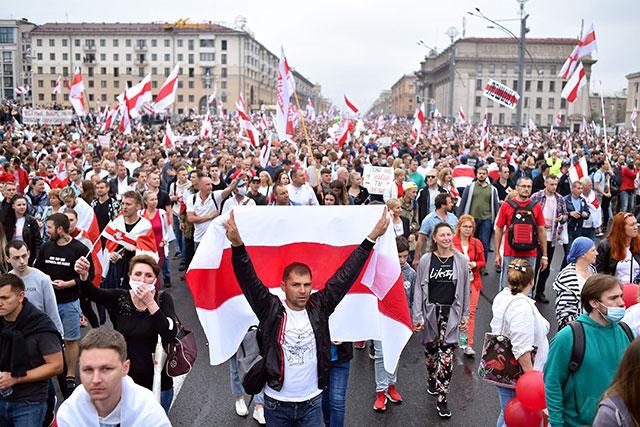You are here
Baltics link arms again in solidarity with Belarus
By AFP - Aug 23,2020 - Last updated at Aug 23,2020

People take part in a solidarity campaign for Belarus people along the border with Belarus in Piedruja, Latvia, on Sunday (AFP photo)
VILNUS — Three decades after their gesture of defiance against the Soviet Union, Baltic residents are linking arms once again on Sunday in solidarity with protesters in Belarus.
On August 23, 1989 millions formed a human chain through the three Baltic states of Lithuania, Latvia and Estonia to express their desire for independence.
On Sunday, thousands are expected to join a human chain stretching some 30 kilometres from the Lithuanian capital Vilnius to the border with Belarus.
Svetlana Tikhanovskaya, the opposition figurehead who fled from Belarus to Lithuania after a disputed presidential election, has said she may attend.
“It means a lot not only for me but all Belarusian people and they feel this support... It’s very beautiful,” she told AFP in an interview on Saturday.
Lithuanian President Gitanas Nauseda, who took part in the original Baltic Way human chain, is also expected to attend the demonstration starting at 16:00 GMT.
“Today is the time for our Belarusian brothers to express their desire for freedom. The Freedom Way is our extended hand for them,” he told AFP.
Organisers say some 50,000 people are expected.
In Latvia, hundreds of campaigners marched along the border with Belarus and then formed a human chain in the village of Piedruja as Belarusian border guards looked on from the other side of the Daugava River.
“This is our Baltic way to express solidarity with all the people in Belarus,” Inese Vaivare, the main organiser, told the cheering crowd in Piedruja.
Peteris Vasks, a Latvian composer who attended the event, said: “We don’t have to live in a cowardly egoism, we can support people of other countries if they want to enjoy basic civic liberties like we do!”
More human chains are planned in the Estonian capital Tallinn and along the iconic Charles Bridge in Prague.
The Baltic Way human chain of 1989 has inspired similar initiatives by freedom-seekers the world over even in recent years — from Hong Kong to Catalonia to Taiwan.
The original was 600 kilometres long and sent the strongest signal to date that the Soviet-occupied Baltic states were on the road towards restored independence, which they all won two years later.
All three are now EU and NATO members.
The Lithuanian human chain will start in Cathedral Square in Vilnius and end at the Medininkai border post — the site of clashes with Soviet law enforcement in 1991 after Lithuania declared its independence.
Kiryl Krivicki, a 20-year-old Belarusian student living in Vilnius said the event “could become the same metaphor of freedom” as the one in 1989.
Tatsiana Chulitskaia, 44, a Belarusian researcher at Vytautas Magnus University, said: “It is important, even if it is a symbolic support.”
“It is essential for Belarusians not to feel alone.”
Related Articles
VILNUS — Several hundred US troops started arriving in NATO member Lithuania on Saturday for military exercises near the border with Belarus
MINSK — Demonstrators massed in central Minsk on Sunday after opposition leaders called for a huge rally to demand the resignation of Belaru
MINSK — Scattered groups of protesters in Belarus on Thursday tried to breathe life into a movement against President Alexander Lukashenko
















